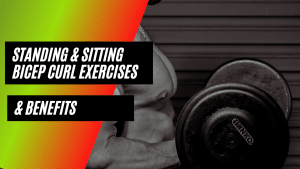How to do a concentration curl and its variations
Concentration is important in most, if not all, exercises. It allows you to be more attentive towards your form and enables you to master the execution of an exercise. In a concentration curl, this action is given even more importance—well obviously, because it is in the name of the exercise itself.
While the concentration curl does not necessarily make the biceps bigger than the regular curl, it does give more emphasis on the contraction of the biceps without the risk of relying on momentum. As a result, the biceps are activated more which means that you are building more strength in that muscle.
But you might be wondering, are there any other ways to do concentration curls? And if there are, what is the most efficient way to do it? Keep scrolling to find out.
What is a concentration curl?
The concentration curl is simply a variation of the bicep curl that allows you to maximize the tension placed on the biceps. Since the exercise requires the arm to be braced against the thigh fixing it in a stationary position, it gives you better control over the movement allowing you to target the biceps more compared to other types of curls.
The primary muscle targeted in this exercise is, well, the biceps. It is composed of the short head and the long head. Together, the two heads are responsible for the flexion of the arm at the elbow and the outward rotation of the forearm, both of which are movements needed to do a curl.
How to do a standard concentration curl
In a regular concentration curl, you need to be in a sitting position. This is usually the ideal way to do the exercise because it prevents you from using momentum to complete a rep. Here is a step-by-step guide on how to do it:
- Begin by setting the bench at a height that will put your knees at a 90-degree angle when you sit.
- Once you are seated on the bench, make sure that your feet are firmly planted on the ground and that it stays that way throughout the exercise.
- Hold a dumbbell in one hand and place your upper arm against the inner part of your thigh. Make sure that your arm is outstretched downwards as you hold the dumbbell off the floor.
- Curl the weight up in a controlled manner, moving only your forearm. Since your upper arm is pressed against your thigh, this position will prevent you from moving your entire arm.
- Once you have reached the top of the movement, squeeze your biceps then lower the dumbbell in a controlled manner to go back to the starting position.
- Repeat according to your desired number of reps then do the exercise with your other arm.
Concentration curl variations to try
Standing concentration curl
Another concentration curl variation that is worth a shot, the standing concentration curl recruits more muscles in the upper body, specifically the core, to stabilize the torso during the lifting part of the exercise.
However, since there is no bench for your thighs to be able to provide support, this exercise will slightly remove some tension from the biceps and shift it to the forearm.
- Begin by positioning yourself in a wide stance with your feet shoulder-width apart and your toes pointing outwards.
- Lean forward and put your right hand on your right knee for support.
- Let your left upper arm rest on the inner part of your left thigh as you outstretch your arms downward to hold the dumbbell with a supinated grip.
- Curl the weight up in a controlled manner to put more tension on the biceps until it reached your shoulder.
- Pause for a few seconds while squeezing your biceps then lower the dumbbell slowly to go back to the starting position.
- Repeat according to your desired number of reps then do the exercise with your other arm.
Plate concentration curl
This variation is similar to the standing concentration curl but with a plate instead of a dumbbell. Since plates do not have handles, using them in concentration curls will demand better grip which, in turn, will improve your grip strength.
- Begin by standing with your feet shoulder-width apart.
- Hold a plate in one hand with a supinated grip, making sure that your arm is outstretched and your palm is facing inwards.
- Let the other hand rest on your knee for support.
- Keep a straight back and a neck that is in line with your spine.
- Curl the weight up in a controlled manner, moving only your forearm while keeping your upper arm still to put more tension on the biceps until the plate reaches your shoulders at the top of the movement.
- Hold that position for at least two seconds before slowly lowering the plate back to the starting position.
- Repeat according to your desired number of reps then do the exercise with your other arm.
Hammer concentration curl
What makes the hammer concentration curl more challenging than the other concentration curl variations is that this exercise puts more emphasis on the long head muscle of the biceps brachii as well as the brachialis and brachioradialis muscles in the forearm.
Moreover, the hammer concentration curl requires a pronated grip, unlike the other variations where the wrist is in a supinated position. With this grip, the long head of the biceps is at a greater disadvantage making the biceps as a whole work harder.
- Begin by sitting on a bench with your feet firmly planted on the ground and shoulder-width apart.
- Hold the dumbbell in one hand with a pronated grip then turn your hand in a 90-degree angle just like you would in a regular hammer curl.
- Let your upper arm press against your inner thigh so that only the forearm will move when you curl and make sure that your arm is outstretched downwards with your palm facing inwards.
- Put your other hand on your knee to support your torso throughout the exercise.
- Curl the weight up towards your chest in a controlled manner while squeezing your biceps as you do this.
- Once the weight reaches your shoulders at the top of the movement, squeeze your biceps more for full contraction.
- Stay in that position for at least two seconds before slowly lowering the dumbbell to go back to the starting position.
- Repeat according to your desired number of reps then do the exercise with your other arm.
Benefits of the concentration curl
Regardless of which variation you do, the biggest benefit of performing concentration curls is strong and well-defined arms. And when you include progressive overloading as you move forward with your concentration curl routine, you further increase the potential of your biceps to grow. This is because when doing concentration curls, specific muscle fibers are targeted and broken down which, as a result, rebuild themselves into something larger via protein synthesis.
Compared to the regular bicep curl, the concentration curl is heavily focused on the biceps because you are prevented from using momentum for the completion of each rep by the way your upper arm is positioned on your inner thigh, therefore eliminating the need to recruit other muscles for stability and support. So if you are someone looking for the perfect exercise that combines hypertrophy, strength, and weight training, you may want to consider switching up your regular bicep curls for concentration curls.
Concentration curl mistakes to avoid
Whether you are doing the seated, standing, plate, or hammer concentration curl, one way or another you are bound to make one or all of these mistakes.
Using momentum
This is a mistake that is not just common for concentration curls but in almost every other exercise, especially the ones that involve the use of heavy weights. Using momentum is practically cheating and this is usually a result of your body compensating for using a weight that is too much for what you can actually handle.
If you find yourself doing this, reduce the weight you are using and choose one that is not too light that you end up not affecting your biceps in any way, and also not too heavy that you end up struggling to even do just one rep.
Curling too fast
The concentration curl is not an exercise that needs a lot of reps so there is no need for you to rush it to do as many as you can. You need to keep the movement controlled throughout the exercise, especially during the lowering portion because the slow movement promotes more muscle growth than when you do it fast. This is because gravity is working to your advantage on the way down which enables you to use more weight. So to maximize the benefits of this exercise, slow and steady is the way to go.
Not keeping your elbows steady
Your elbow is pressed against your inner thigh for a reason, and that is to keep you from using your entire arm to curl. The temptation to flare out your elbows is especially common among beginners to weight training, but even long-time fitness junkies can still make this mistake from time to time. So to avoid this, make sure that you maintain a straight back and be 100% conscious about your upper arm and elbows being pinned to your inner thighs throughout the entire exercise.



